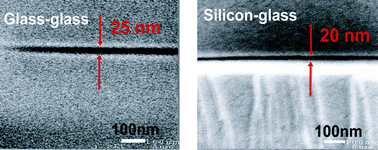Fabrication and characterization of 20 nm planar nanofluidic channels by glass–glass and glass–silicon bonding
Abstract
We have characterized glass–glass and glass–Si bonding processes for the fabrication of wide, shallow nanofluidic channels with depths down to the nanometer scale. Nanochannels on glass or Si substrate are formed by reactive ion etching or a wet etching process, and are sealed with another flat substrate either by glass–glass fusion bonding (550 °C) or an anodic bonding process. We demonstrate that glass–glass nanofluidic channels as shallow as 25 nm with low aspect ratio of 0.0005 (depth to width) can be achieved with the developed glass–glass bonding technique. We also find that silicon–glass nanofluidic channels, as shallow as 20 nm with aspect ratio of 0.004, can be reliably obtained with the anodic bonding technique. The thickness uniformity of sealed nanofluidic channels is confirmed by cross-sectional SEM analysis after bonding. It is shown that there is no significant change in the depth of the nanofluidic channels due to anodic bonding and glass–glass fusion bonding processes.


 Please wait while we load your content...
Please wait while we load your content...